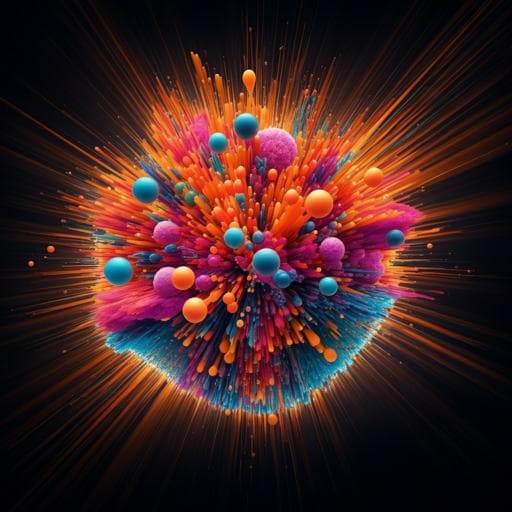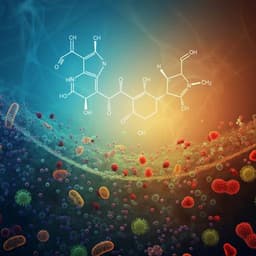
Chemistry
Effective screening of Coulomb repulsions in water accelerates reactions of like-charged compounds by orders of magnitude
A. Kowalski, K. Bielec, et al.
Discover how recent research by Adam Kowalski, Krzysztof Bielec, and their colleagues has revolutionized the understanding of reaction kinetics between like-charged compounds in water. Their groundbreaking work reveals that enhancing local concentrations through screening can amplify reaction rates by millions of times, pushing the boundaries of what we thought possible in chemical reactions.
~3 min • Beginner • English
Introduction
Like-charged molecules in aqueous media experience Coulomb repulsion that makes productive encounters rare and slow; reactions can take days to weeks at neutral conditions. Enzymes in biology accelerate such processes largely through electrostatic stabilization. Synthetic mimics (e.g., nanozymes) often struggle to replicate active-site charge effects and tend to be reaction-specific. Motivated by a prior observation that positively charged polymers can accelerate reactions between negatively charged reactants via diffusive binding along charged tracks, this study asks whether oppositely charged species can generally catalyze reactions between like-charged molecules by screening repulsion and increasing local reactant concentration. The authors test this using two independent systems: a covalent reaction between Coenzyme A (CoA) and a bromomaleimide-functionalized CoA (CoA-M), and a non-covalent reaction, DNA duplex formation (hybridization). They investigate how salts, zwitterions, charged monomers, oligomers, polymers, and micelles affect rates and develop a theoretical framework linking acceleration to catalyst surface charge density.
Literature Review
Prior work established that electrostatics plays a major role in enzyme catalysis (Warshel and others) and that synthetic catalysts (e.g., nanozymes) have difficulty reproducing enzyme active-site electrostatics. The authors previously reported significant acceleration for reactions between negatively charged reactants when adding positively charged polymers, attributing it to diffusive binding (reactants sliding along a charged molecular track). Micellar catalysis and ionic strength effects on reactions are well documented, and zwitterions’ contributions to effective screening and ion pairing have been debated; the study references literature on micelles, ionic strength, and buffer effects to contextualize the screening mechanisms explored here.
Methodology
Two experimental models were used: (1) Covalent reaction between CoA and bromo-N-methylmaleimide substituted CoA (CoA-M), producing CoA-M-CoA with increased fluorescence upon product formation; (2) DNA hybridization between two 13-nt complementary strands labeled with donor (ATTO488) and acceptor (ATTO647N), monitored by FRET. Reaction kinetics for CoA/CoA-M were analyzed as a second-order process A + B → AB. The kinetic model relates fluorescence intensity I_t to product concentration and uses kt = I_t / [t (I_f − I_t)] to obtain time-resolved k_t and a weighted mean k; intermediates due to catalyst binding were assumed reversible and not rate-limiting for the global second-order treatment. Conditions: typically 10 µM each reactant, T = 25 °C, in Milli-Q water or buffers (e.g., 50 mM MES pH 6.1 for CoA; 1 mM phosphate buffer or water + 0.002% Tween 20 for DNA). Catalysts: salts (NaCl), zwitterions (MES), net-positively charged monomer (arginine), oligomer (nona-arginine, Arg9), polymer (poly-L-lysine, ~135-mers), cationic surfactants/micelles (CTAC, CPC, BTC), and controls (neutral Brij L23, anionic SDS). For net-charged catalysts, concentrations were adjusted so that total positive charges matched the total negative charges on reactants (e.g., 80 µM Arg for 8 charges per reaction pair, 8.9 µM Arg9, 0.6 µM poly-L-lysine). Micelle conditions considered CMC and aggregation numbers (CTAC CMC: 1.06 mM in water, 0.70 mM in 50 mM MES; aggregation number ~81). Kinetics were measured by confocal fluorescence time traces and analyzed with custom Python scripts; additional stopped-flow fluorometry was used for selected measurements. For DNA hybridization, pulsed interleaved excitation and TCSPC enabled FRET-based monitoring of acceptor emission growth following 485 nm excitation of the donor. Theoretical analysis: Debye–Hückel approximation near a flat, charged surface to derive κ = q χ λ_D / (2π ε ε0 kT), where q is reactant charge, χ is catalyst surface charge density, and λ_D is Debye length. Smoluchowski transport to a reactive surface relates flux-limited rate to κ, predicting k ≈ −k0 κ for sufficiently negative κ and an optimal catalyst concentration due to competing effects of local enrichment vs. partitioning across many catalyst particles.
Key Findings
- In pure water, CoA/CoA-M reacts very slowly: k ≈ 0.05 M^-1 s^-1; completion takes ~2 months at 10 µM each reactant.
- Salts screen repulsion and accelerate reactions: 50 mM NaCl gives k ≈ 12.9 M^-1 s^-1 (~250× vs water); increasing ionic strength decreases Debye length and effective charge.
- Zwitterions (MES) also accelerate despite lower ionic strength: 50 mM MES, pH 6.1 gives k ≈ 22.74 M^-1 s^-1, about twice 50 mM NaCl; at 500 mM MES, k ≈ 39.0 M^-1 s^-1.
- Net-positively charged species yield larger accelerations at fixed total charge: with 50 mM MES + 80 µM arginine, k ≈ 43.2 M^-1 s^-1 (≈2× over 50 mM MES). Increasing charge per catalyst (Arg9, poly-L-lysine) markedly boosts rates; poly-L-lysine (0.6 µM) yields k ≈ 1.24 × 10^4 M^-1 s^-1, ~10^5-fold vs water. The effect is not due to bulk ionic strength (only marginally increased by low catalyst concentrations) but to accumulation of reactants near catalyst surfaces and increased local concentration.
- Higher MES concentration at fixed Arg9 slows the reaction, consistent with ion–dipole interactions reducing reactant association with the net-charged catalyst.
- Micelles: For CTAC, above its CMC, micelles catalyze reactions more effectively than monomeric surfactant. CTAC micelles in water show higher k than in MES due to fewer ion–dipole interactions; at fixed micelle concentration (8 µM) and increasing MES, k decreases, with a maximum in water (reported k ≈ 2.27 × 10^0 M^-1 s^-1). Varying CTAC micelles in water reveals a non-monotonic dependence with an optimal micelle/reactant ratio (evidence for a balance between local enrichment and partitioning). At constant micelle concentration (20 µM) in water, positively charged micelles strongly accelerate: CPC k ≈ 2.95 × 10^3 M^-1 s^-1; BTC k ≈ 7.67 × 10^2 M^-1 s^-1; CTAC k ≈ 2.91 × 10^0 M^-1 s^-1. Neutral Brij and anionic SDS do not accelerate, confirming the electrostatic origin.
- DNA hybridization: In ultrapure water no duplex formation is observed over >2 weeks; adding 1 mM phosphate buffer enables complete product in ~70 h. In the presence of oppositely charged catalysts (in water with 0.002% Tween 20), hybridization rates are substantially increased, paralleling the CoA system trends.
- Theory: Reaction rate scales linearly with −κ (k ≈ −k0 κ), where κ depends on catalyst surface charge density and screening length. Experimental data for both CoA and DNA collapse on linear k vs −κ, supporting a unified, transport-driven electrostatic enrichment mechanism. An optimal catalyst concentration exists; at very low catalyst levels, flux to catalyst limits rate; at very high catalyst levels relative to reactants, reactants are partitioned across many particles, reducing two-reactant encounters.
Discussion
The study demonstrates that electrostatically mediated local enrichment of like-charged reactants at oppositely charged catalyst surfaces can overcome Coulomb repulsion and accelerate reactions by orders of magnitude. Conventional ionic strength screening (salts, zwitterions) provides up to ~10^3-fold acceleration, whereas net-charged oligomers/polymers and cationic micelles yield 10^4–10^6-fold enhancements by concentrating reactants at their charged surfaces and facilitating surface diffusion and encounters. The absence of acceleration with neutral or negatively charged micelles and the slowdown upon increasing zwitterion concentration at fixed net-charged catalyst highlight the electrostatic nature and the competition between ion–dipole pairing and reactant binding. The same mechanism applies to covalent (CoA/CoA-M) and non-covalent (DNA hybridization) systems, indicating generality. The theoretical model, linking rate to the parameter κ that captures catalyst surface charge density and screening, quantitatively rationalizes the linear dependence of k on −κ and predicts the existence of an optimal catalyst concentration. These findings provide a route to tune reaction rates over several orders of magnitude by controlling catalyst charge magnitude, distribution, and environment.
Conclusion
Screening Coulomb repulsions and increasing local reactant concentration at oppositely charged surfaces enables dramatic acceleration of reactions between like-charged molecules. In the CoA/CoA-M model, salts and zwitterions accelerate by ~10^3-fold, net-charged oligomers/polymers by ~10^4–10^5-fold, and cationic micelles by >10^6-fold. Similar acceleration is achieved for DNA hybridization, demonstrating generality across covalent and non-covalent processes. A transport-focused electrostatic model captures the dependence of the rate on catalyst surface charge density and screening length, offering predictive control. Future work should optimize catalyst surface charge density and topology, quantify the trade-off between local enrichment and partitioning to locate global optima, and extend to complex biomolecular assemblies and sensing applications where rate amplification can act as a signal gain mechanism.
Limitations
- Reported kinetic constants for micelles show some condition-dependent variability and potential inconsistencies likely due to differences in micelle/reactant ratios, buffer interactions, and experimental constraints; careful normalization across conditions is needed.
- The theoretical model uses Debye–Hückel approximation and a flat-surface assumption, neglecting curvature and discrete charge effects; real micelles and polymers have finite curvature and heterogeneous charge distributions.
- The proportionality constant k0 is system-specific and difficult to determine from first principles; predictive power requires experimental calibration.
- Stopped-flow measurements with micellar systems may be affected by shear-induced micelle dynamics, potentially altering effective catalyst concentration during mixing.
- Generalization beyond the tested reactants (CoA derivatives and 13-nt oligos) may depend on molecular size, charge distribution, sequence, and specific binding chemistries; pH and buffer composition can modulate both screening and ion–dipole interactions.
Related Publications
Explore these studies to deepen your understanding of the subject.







